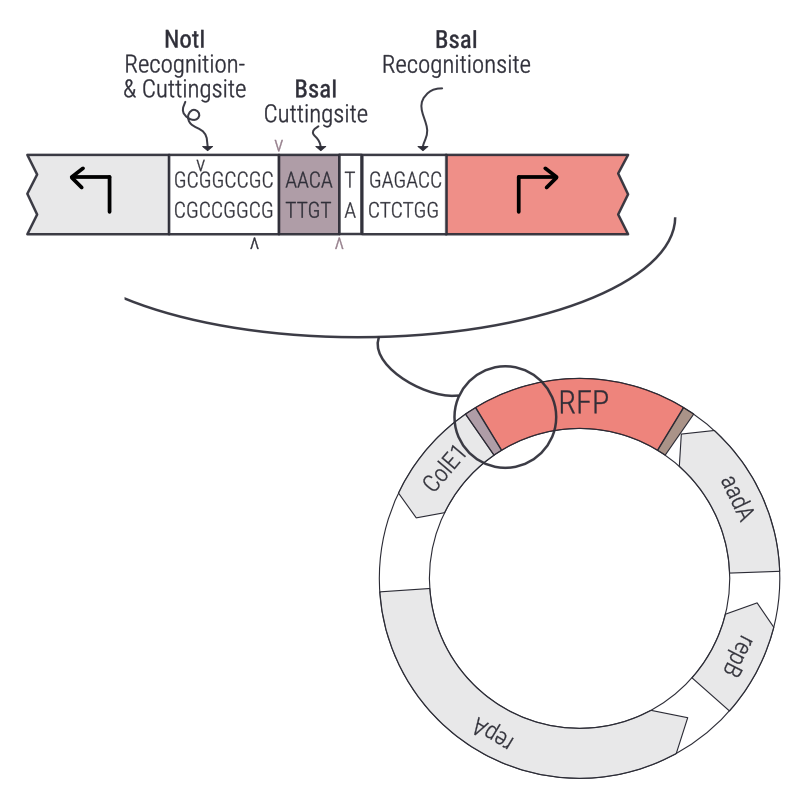pMC_0_7+8_panS_specResLVL1
Sequence and Features
- 10INCOMPATIBLE WITH RFC[10]Illegal XbaI site found at 1199
Illegal PstI site found at 3734 - 12INCOMPATIBLE WITH RFC[12]Illegal PstI site found at 3734
Illegal NotI site found at 1
Illegal NotI site found at 5738 - 21INCOMPATIBLE WITH RFC[21]Illegal BglII site found at 4897
Illegal XhoI site found at 1249 - 23INCOMPATIBLE WITH RFC[23]Illegal XbaI site found at 1199
Illegal PstI site found at 3734 - 25INCOMPATIBLE WITH RFC[25]Illegal XbaI site found at 1199
Illegal PstI site found at 3734
Illegal NgoMIV site found at 48
Illegal NgoMIV site found at 190 - 1000COMPATIBLE WITH RFC[1000]
B A S I C P A R T S
The origin
Inspired by the fast progress in Synthetic Biology and its urgent need for genetic tools that enable the
exploitation of cyanobacteria for research and biotechnological applications, we set out to construct the most
versatile shuttle vector for cyanobacteria based on the modular Golden Gate Assembly method, allowing for flexible
cloning into a reliable self-replicating system.
Introduction of exogenous DNA can be done in multiple ways and propagated in a strain if it is integrated in the
chromosome or stably expressed on a self-replicating plasmid.
For rapid prototyping in cyanobacteria
self-replicating plasmids are of higher interest than genome-integrations, as the latter can be quite
time-consuming in cyanobacterial strains with multiple genome copies (Griese et al., 2011). Furthermore, genes
introduced in self-replicating vectors have been shown to have higher gene-expression levels than those integrated
in the genome, as copy numbers are typically higher (Chen Titel anhand dieser DOI in Citavi-Projekt übernehmen et
al., 2016) – a desirable trait, not just for rapid prototyping in research applications, but also for
biotechnological production of valuable compounds.
With our shuttle-vectors encompass a cyanobacterial origin of replication (ori) from Synechococcus
elongatus PCC7942 as well as an E.coli ori, which is perfect for fast cloning processes, as these
vectors can be easily recovered from the cyanobacteria and reintroduced in an E.coli strain.
Currently existing shuttle vectors for cyanobacteria are still based on standard systems working with multiple
cloning sites (MCS) for expression of homologous genes (Chen Titel anhand dieser DOI in Citavi-Projekt übernehmen et
al., 2016). A huge downside is that these vectors include either an MCS (e.g. pAM5188) or a
fluorescence reporter (e.g. pAM4787), which is unpractical for easy selection of recombinant clones. Additionally,
an MCS comes with possible sequence constraints due to restriction sites leaving unwanted base pairs in your
constructs.
Facilitating and standardizing the process of engineering biological systems is one of the fundamental goals of
synthetic biology (Shetty Titel anhand dieser DOI in Citavi-Projekt übernehmen et al., 2008), so the
construction of a shuttle-vector based on a modular cloning method significantly improves the genetic toolbox we
created for genetic engineering and synthetic biology approaches in S.elongatus and other
cyanobacteria.
The commonly used S.elongatus strain PCC7942 carries two endogenous plasmids, the 46,4kb pANL (Chen et al., 2008) which is essential and the
7,8kb pANS (Van der Plas et al., 1992) which is
not essential for the strain and can easily be cured.
This small plasmid has already been used for construction of shuttle vectors (Kuhlemeier Titel anhand dieser DOI in Citavi-Projekt übernehmen & van Arkel, 1987 ; Golden & Sherman, 1983 ; Chen Titel anhand dieser DOI in Citavi-Projekt übernehmen et al., 2016).
We followed this lead to create the best shuttle-vector available for cyanobacteria by encompassing the minimal
replication region of pANS and the ColE1 origin of replication into our vectors, allowing for stable
self-replication with high copy numbers in cyanobacteria (Chen Titel anhand dieser DOI in Citavi-Projekt übernehmen
et al., 2016) and E.coli (Gerhart Titel anhand dieser DOI in Citavi-Projekt übernehmen
et al.,2002). This addition to the genetic toolbox proves invaluable, as it can be easily recovered
from the cyanobacterial strain and reintroduced in E.coli for fast GoldenGate-based cloning processes.
In order to supply the community with an easy selection system, we equipped our shuttle vector with a fluorescent
reporter that is cut out when introducing new genetic parts:
A mRFP (red fluorescent protein) cassette is flanked by our standardized TypeIIS restriction enzyme recognition
sequences (BsmBI or BsaI depending on what level you want to clone in). In a standard Golden Gate reaction this
cassette will drop out and leave space for the parts that should be introduced, allowing for easy selection on
plate after successful cloning – red colonies are wrong, still harboring the mRFP cassette and white colonies (if
no other fluorescence is introduced) are correct, as the mRFP was switched with the parts of interest.
This crucial part comes in two variations - one for cloning Lvl1 and one for Lvl2 constructs -, giving the Golden
Gate community everything they need for successful and reliable creation of self-replicating vectors in
cyanobacteria.
This part is contained in the Green Expansion, a range of parts from iGEM Marburg 2019that enables users of the Marburg Collection 2.0 to design MoClo compatible vectors for cyanobacteria as well as to engineer the genome of several cyanobacterial species.
The Green Expansion
The Green Expansion is an addition of parts to the Marburg Collection 2.0 (See: Design of the Marburg Collection) that features the world's first MoClo compatible shuttle vector for cyanobacteria. BBa_K3228069
The Green Expansion also offers all the parts needed for the genomic integration of one or multiple genes in cyanobacteria. This M.E.G.A. (Modularized Engineering of Genome Areas) kit convinces with a striking flexibility and a very intuitive workflow for the de novo assembly of your plasmid of choice. It encompasses five different neutral integration sites to choose from: three conventional sites frequently used in the cyanobacterial community (NSI to NSIII) as well as our own rationally designed artificial Neutral integration Site options a.N.S.o. 1 and 2 (See: Finding new artificial Neutral integration Site options).These sites show no transcriptional activity from neighboring regions according to RNA-seq data and are therefore completely orthogonal. Additionally we offer four different antibiotic markers to use (chloramphenicol, gentamicin, spectinomycin and kanamycin). With the Green Expansion up to 20 genes can be introduced into a cyanobacterial strain.
Thanks to the flexible design this expansion can also be used for the genomic modification of any chassis after the introduction of a new species specific LVL 0 integration sites to our Marburg Collection 2.0. As the workflow to build new homologies is a bit more intricate compared to the one pot on step assembly of our other parts due to the internal BsmBI cutting site, we described the workflow for that in our design section (See: Design of neutral integration sites).
The Green Expansion proves a valuable addition to our Marburg Collection 2.0 and to the iGEM Registry of Standard Biological Parts. It services users of our chassis and other cyanobacterial strains with a useful tool for genomic modifications but it also contributes a shell that can be used to modify any other model organism as well.
Compability
These parts are compatible with the RCF [1000] standard and can be used in any part collection that uses the PhytoBrick standard of overhangs. For more information we recommend to head over to Design of the Marburg Collection iGEM Marburg 2018.
Parts of the Green Expansion





